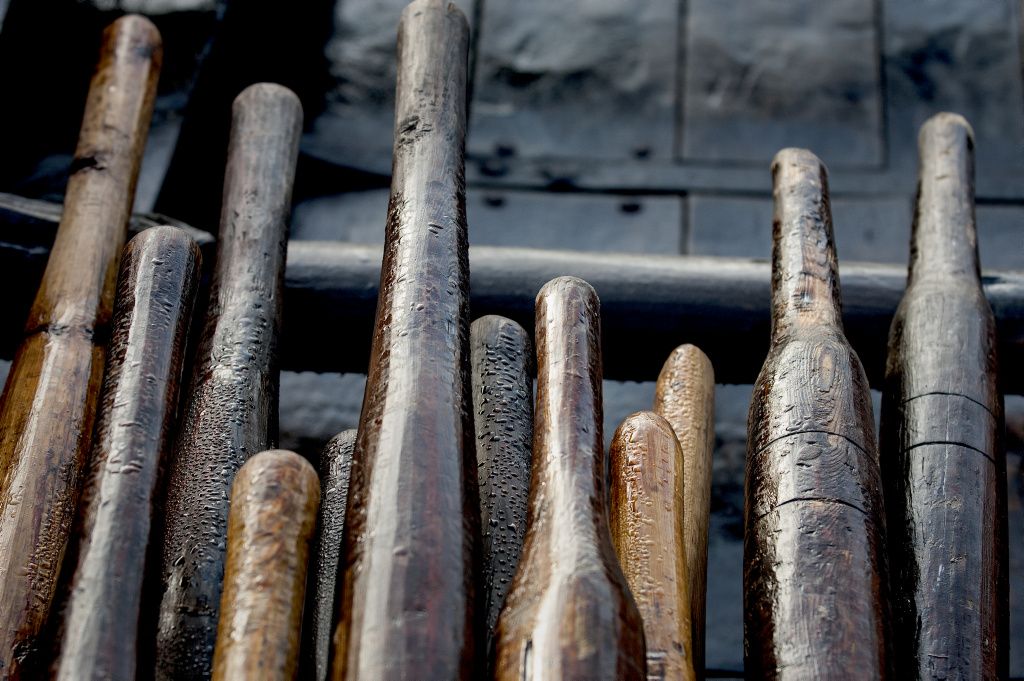
At the boatyard, there is ongoing research, which is published as reports that can be downloaded free of charge from the museum's website
The reports describe, among other things, part of the Viking Ship Museum's experimental archaeological research.
Work reports
This report was written in 2009 by ropemaker Ole Magnus (1948-2009). The report details Ole Magnus’ work with manufacturing ropes for five of the Viking Ship Museum in Roskilde’s reconstructions of the Skuldelev Ships. An endeavour that extended over more than 30 years with short-term contracts.
Ole Magnus’ background for working with rope for the reconstructions was that of the craftsman. After having taken over Fur Rebslåeri in 1975, Ole Magnus spent the rest of his life working with the traditional manufacture of rope.
In 1983, he received an order for the manufacture of hemp rope for the reconstruction (Roar Ege) of a Viking ship, which was being built at the Viking Ship Museum. This was followed by a long series of projects involving the production of rope for the Viking Ship Museum’s reconstructions of Viking Age and Medieval ship and boat finds.
The last project Ole Magnus was involved in was the production of rope for the 30 m long reconstruction of the Skuldelev 2 ship-find (Sea Stallion from Glendalough), which was launched in 2004. Here, for the first time, Ole Magnus was involved in the whole process, from the planning phase through to the production, testing and use of the ropes.
In 1898, the linguist Jakob Jakobsen made note of a story which told of how at Túali on Mykines, there once lived a Norwegian by the name of Benjamin, who owned a teinæringur, and that the boat had bells mounted on the oar locks, which rang when the boat was rowed. Interestingly, land records appear to attest to this claim: from 1640-1653, a farmer named Benjamin Guttesen lived at Túali on Mykines.
In 1947, 49 years later, the story of the great boat was still alive on Mykines. Then, geologist Jóannes Rasmussen told archaeologist Sverra Dahl, what he had heard about the teinæringur. The boat was rowed by 18 men and used for transport of goods between harbours and also for the journey north to Eiðis for the Christmas celebrations. The footprint of the naust where the boat was said to have stood could still be seen.
The persistence of the story concerning the teinæringur on Mykines in the middle of the 1600’s still fascinates those interested in boats on the Faroe Islands. On the 24th October 1999, an association was established with the aim of testing a teinæringur built within the Faroese boatbuilding tradition.
The association then asked the Viking Ship Museum’s Faroese boatbuilder, Hanus Jensen, to build a scale-model of the teinæringiur. Hanus Jensen agreed and as a parallel project, Erik Andersen – the Viking Ship Museum’s sail expert – would propose a design for the rig for the large boat, based on this model. This process resulted in Hanus Jensen’s fine construction model and this rig reconstruction report.
Since 1977, with ship-reconstructor Erik Andersen as the indefatigable driving-force, the Museum has carried out a long-term experimental archaeology project concerning the manufacture and testing of wool cloth for square-sails. The research has taken place in collaboration with textile craft experts, engineers and boat-users. Wool sails of different size and quality have been produced for different vessels, with a starting-point in the analysis of archaeological textile fragments and surviving sails from more recent times.
Nearly two years work
The most recent element of this work has been the production of a 25m2 wool sail for one of the Museum’s traditional west Norwegian boats, a so-called Oselver. The material was woven on an upright warp-weighted loom located in the Viking Ship Museum’s exhibition. The work began in July 2006 and continued until May 2008. Museum guests could closely follow weaver Anna Nørgaard’s work. This harmonised well with the work at the Museum boatyard and demonstrated how maritime culture and seafaring have been borne by time-consuming craftwork carried out by women, building on an extensive knowledge about wool’s properties, selection, processing and use.
The wool sail project has always been dependent upon generous donors. The production of Oselven’s wool sail is no exception. Arne Vinther, a member of the Friends of the Viking Ship Museum, and the association Friends of the Viking Ship Museum provided the financial basis that made both the weaving of the sailcloth and the sewing of the sail possible.
First time
”The project ’Oselven’s Sail’ has brought the Museum’s experimental archaeological research into wool sail a good step further. This is the first time we have produced a complete sail on a Viking Age type loom. This has given a different qualitative insight and experience than we have previously achieved with the manufacture of smaller test-panels on a warp-weighted loom.” tells the Viking Ship Museum’s director, Tinna Damgård-Sørensen, who has written the foreword to the report.
As can be seen in the report, as a result of the extensive work process, Anna Nørgaard has had the chance to undertake a more realistic estimate of the amount of time required, the work processes involved and how the tools can be used. She has also documented traces of wear on tools and weight-loss of the loom weights.
» Download the work report 'A wool sail to Oselven' here (Danish only)...